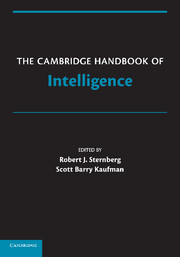Book contents
- The Cambridge Handbook of Intelligence
- The Cambridge Handbook of Intelligence
- Copyright page
- Dedication
- Contents
- Contributors
- Preface
- Part I Intelligence and Its Measurement
- Chapter 1 History of Theories and Measurement of Intelligence
- Chapter 2 Tests of Intelligence
- Chapter 3 Factor-Analytic Models of Intelligence
- Chapter 4 Contemporary Models of Intelligence
- Part II Development of Intelligence
- Part III Intelligence and Group Differences
- Part IV Biology of Intelligence
- Part V Intelligence and Information Processing
- Part VI Kinds of Intelligence
- Part VII Intelligence and Society
- Part VIII Intelligence in Relation to Allied Constructs
- Part IX Moving Forward
- Author Index
- Subject Index
Chapter 1 - History of Theories and Measurement of Intelligence
from Part I - Intelligence and Its Measurement
Published online by Cambridge University Press: 05 June 2012
- The Cambridge Handbook of Intelligence
- The Cambridge Handbook of Intelligence
- Copyright page
- Dedication
- Contents
- Contributors
- Preface
- Part I Intelligence and Its Measurement
- Chapter 1 History of Theories and Measurement of Intelligence
- Chapter 2 Tests of Intelligence
- Chapter 3 Factor-Analytic Models of Intelligence
- Chapter 4 Contemporary Models of Intelligence
- Part II Development of Intelligence
- Part III Intelligence and Group Differences
- Part IV Biology of Intelligence
- Part V Intelligence and Information Processing
- Part VI Kinds of Intelligence
- Part VII Intelligence and Society
- Part VIII Intelligence in Relation to Allied Constructs
- Part IX Moving Forward
- Author Index
- Subject Index
Summary
- Type
- Chapter
- Information
- The Cambridge Handbook of Intelligence , pp. 3 - 19Publisher: Cambridge University PressPrint publication year: 2011
- 28
- Cited by

